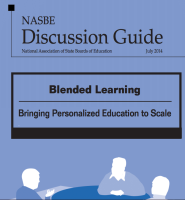NASBE Articles Guide State Boards to Craft Policies That Encourage Blended Learning
 Blended learning has the potential to transform instructional roles, structures, staffing, schedules and budgets. According to a new series of articles from the National Association of State Boards of Education (NASBE), state boards of education are key to facilitating these changes, since they are responsible for adopting policies that encourage, support and oversee the implementation of personalized learning systems.
Blended learning has the potential to transform instructional roles, structures, staffing, schedules and budgets. According to a new series of articles from the National Association of State Boards of Education (NASBE), state boards of education are key to facilitating these changes, since they are responsible for adopting policies that encourage, support and oversee the implementation of personalized learning systems.
The NASBE articles, written with the expertise of blended learning leaders Lisa Duty of The Learning Accelerator, John Bailey of Digital Learning Now!, iNACOL’s Susan Patrick, NASBE Executive Director Kristen Amundson and writer-consultant James Bogden, explore the strengths and challenges of implementing blended learning policies and the role that state boards of education play.
Blended Learning: Bringing Personalized Education to Scale, a discussion guide, explains what blended learning is, outlining for state board members and other policymakers the various models of blended learning, the pros and cons of each and tactics to consider during the policymaking process. Two companion case studies, Blended Learning in the Classroom and Rhode Island’s Blended Approach to Blended Learning, give a first-hand look at how blended learning is being implemented in a small, urban school district and in the state of Rhode Island, concluding with lessons learned from each.
The articles also highlight shared elements of blended learning policies that encourage an innovative culture, ensure access to the proper technology infrastructure, take into account instructional and assessment requirements and provide support to teachers as they make the transition to blended learning.
About the Author
Christopher Piehler is the former editor-in-chief of THE Journal.